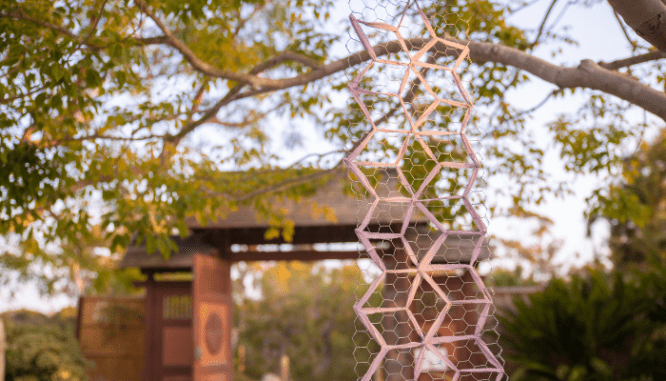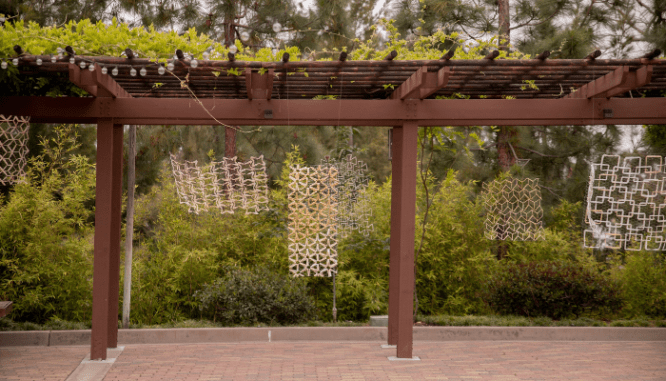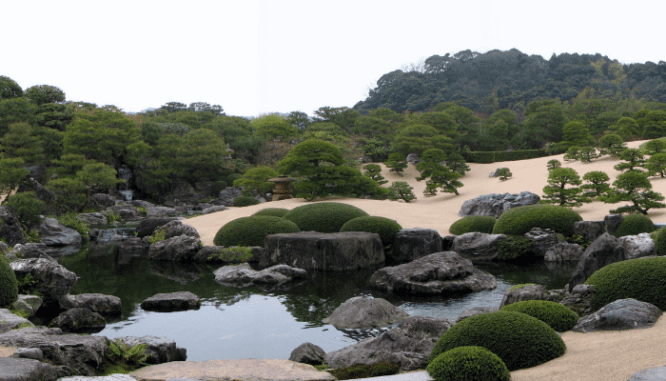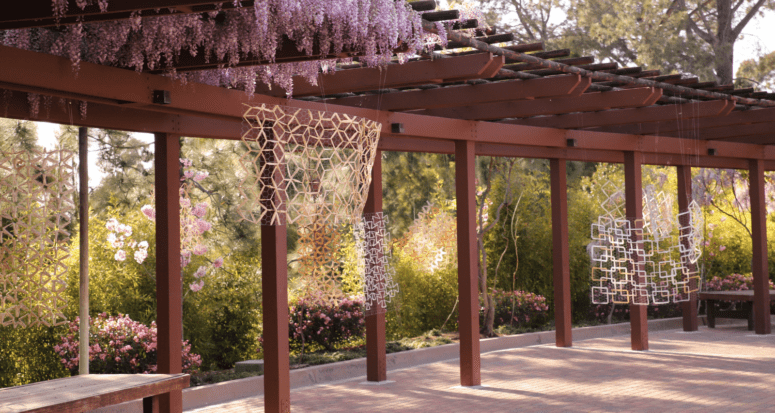Shakkei for Homeowners: Borrow Surrounding Scenery to Elevate Your Garden
- Published on
- 5 min
-
 Gina Rodrigues Contributing AuthorClose
Gina Rodrigues Contributing AuthorClose Gina Rodrigues Contributing Author
Gina Rodrigues Contributing AuthorGina is a freelance writer and editor who specializes in real estate and personal finance. She brings more than ten years of experience as a licensed agent and property investor. When she isn’t writing, she can be found tending to the sheep and chickens at her suburban homestead outside of Seattle. Gina holds a B.A. in English from California State University.
The grounds appear endless when you gaze at the garden of the Adachi Museum of Art in Japan — vastly larger than its 40 acres (or 165,000 square meters). Its boundaries seem virtually impossible to identify as the emerald landscape stretches into the distance. The view culminates to a mountain range horizon swathed in greenery. It begs the question: Where does the Adachi garden end?

The quandary comes courtesy of an ancient East Asian concept, known as shakkei in Japan and jièjǐng in China. Though not a direct translation, the essence of shakkei conveys the concept of “borrowed scenery.”
“I always explain [shakkei] as, a designer takes a distant mountain,” describes Kristi Lin, a landscape designer, and artist who applied the shakkei concept to a 2021 art installation at the Japanese Friendship Garden in San Diego. “The mountain is way off in the background, but the designer incorporates it into the garden composition.”
The end result: a seamless connection between the distant landscape and the foreground.
Teiji Itoh, author of Space and Illusion in the Japanese Garden, defines shakkei in almost spiritual terms, writing: “It means a landscape captured alive … Understanding of the term shakkei does not mean a true understanding of the concept unless there is an actual sensation of what it signifies.”
According to Lin, that sensation includes harmony. “The overall concept [of shakkei] is harmony between the garden and the surrounding environment,” she explains.

Origins: Shakkei stems back to ancient garden design
Shakkei is commonly aligned with Japanese gardens, but the concept can be identified in other East Asian gardens. It’s thought to have originated during Japan’s Asuka period, sometime between 538-710. Later, the design theory gained popularity during the Meiji and Taisho eras between 1868-1926.
Shakkei hinges on the designer’s intent of what view to incorporate into a space. Do you frame a scene around a high-rise structure looming over the landscape? Or do you plant trees to obscure the building and borrow instead from the snow-capped mountain range, planting pine trees to echo the mountain’s forest terrain?
Shakkei also employs scale and perspective by using topography and plant size to frame views that seamlessly entwine background landscapes with its foreground. A garden’s trellis, climbing rose archway, or tree planting can frame the borrowed element, incorporating the distant background into the garden.
Modern-day shakkei: Spilling onto the art scene
Today, Lin sees shakkei being used as more of an underlying design concept rather than a style that designers explicitly incorporate into their work. “I never have heard of some contemporary landscape designer [say], I’m using shakkei,” she notes.
Still, the shakkei approach isn’t lost in modern-day landscape design. “I think you’re always borrowing and incorporating what is beyond your sight,” says Lin.
While landscape designers may not typically draw from shakkei directly, some modern artists have borrowed inspiration from the old landscaping tradition — translating the concept of shakkei into works of art.
In early 2021, Lin drew inspiration from shakkei for her art installation at the Japanese Friendship Garden in San Diego, California.
“My cultural roots are — I’m half Japanese and half Chinese. But since I’ve always grown up here [in the U.S.], it’s like those Japanese and Chinese cultures are like distant mountains that I’m trying to incorporate into my life,” she reveals.
Lin created a series of woven screens that framed views of the friendship garden. The screens were made of her own clothes, dyed in food scraps such as avocados and onion skins. “That represented my garden composition,” she says.
In London, artist June Mineyama-Smithson credits the principle of shakkei for breaking her out of an inspiration funk during the 2020 pandemic lockdown. She borrowed friends’ views from all over the world to create a series of posters that expressed her own, as well as friends’, experiences around the world during the pandemic.
“It’s about looking at the bigger picture, and so I decided to do this with my own work and make use of all the contacts that I’ve made on a global level,” details the artist in an interview with FLO London.

Borrow scenery for your own home
You don’t have to be a renowned artist or tend to a Japanese-style garden to incorporate shakkei into your home. Lin says that you can pull off the concept with other design styles, such as a Pacific Northwest rain garden or country cottage garden. Whether you want to create a serene space or simply want to make a tiny garden look larger, try channeling shakkei principles using these tips:
Study the distant scenery around your garden. What does the current view look like? Do you see a mountain range, a canyon, or water view? Or does the sky touch the horizon unimpeded? Pay attention to the lines, colors, and textures that draw your eye from one area to the next. If the distant scene includes evergreen conifer trees, think about including lush green foliage in your own space.
Also, take note of views that you’d rather not see. Does your next-door neighbor’s dilapidated tool shed distract from your garden? Consider planting trees or other foliage to screen less desirable scenes from sight.

Select elements you’d like to borrow. After evaluating the surrounding scene, look at your existing space. Then decide what you’d like to bring in, or borrow. If you’re surrounded by rolling hillsides rippling with tall grasses, you could echo the aesthetic by planting ornamental grass.
And you could borrow from more than the faraway landscape. You could also draw borrowed inspiration from a closer vantage point, such as a neighbor’s arbor swathed in grape vines.
Frame visual scenes using both structural and plant elements. At the Japanese Friendship Garden in San Diego, Lin’s woven screens framed and captured intentional views of the garden. Another method of framing includes the use of “moon windows,” or circular openings in fences and walls. Archways, trellises, and gaps between hedges can also serve as visual frames.
Lin describes working on a landscape project that includes a canyon view. “There’s going to be a trellis and trees so that the posts of the trellis and trees create a frame on both sides … The canyon becomes our borrowed scenery.”
Extend your space by creating continuity. Placing plants and structures at different heights can make a space look larger. By playing with perspective, you can trick the eye into thinking that a distant scene appears closer than it actually is. When coupled with a sense of continuity, or mimicking a background scene in the foreground, the visual deception can make the foreground look larger.
Bring shakkei indoors. Shakkei isn’t just a design concept for outdoor spaces. Indoors, a vignette of potted plants can echo your garden. A grouping of river rocks can borrow from a trickling stream that runs through your property.
Lin adds that the beauty of shakkei in the garden lies in its reflection of seasonal changes, echoing Itoh’s perspective of capturing scenery that’s alive. “Scenery naturally changes with the seasons,” Lin says. Over time, the borrowed views you have from the inside of your garden will change.”
Header Image Source: (“Borrowed Scenery” an installation by artist Kristi Lin. Photographed by Beto Soto.)
